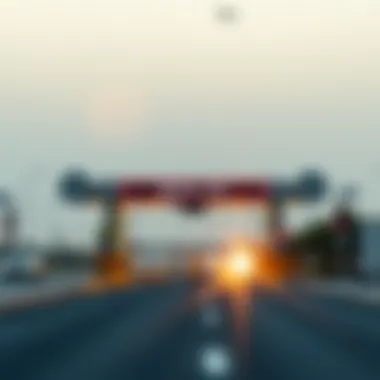Understanding Salik Roads in Dubai: Key Insights


Intro
The Salik road system has been a pivotal development in the urban mobility landscape of Dubai. This toll system reshaped traffic patterns, influencing the daily commutes of residents and visitors alike. The system's design aims to reduce congestion on major roads while enhancing funding for vital infrastructure projects. As Dubai continues to grow and evolve, understanding the implications of Salik is crucial for anyone navigating the city, whether you're a resident, investor, or professional.
Commuting in Dubai isn't just about the roads and cars; it's about the extensive network that binds neighborhoods together and propels the economy. Salik, which means 'open' in Arabic, represents more than just a toll; it stands as a testament to the UAE's ongoing commitment to innovation and improving the quality of life for its citizens and visitors.
This article breaks down the nuances of the Salik system, examining its operational framework, user feedback, economic ramifications, and future developments, offering insights that will help stakeholders make informed decisions.
Understanding Salik: An Overview
Understanding the Salik system is vital for anyone navigating the bustling roads of Dubai. It's not merely a toll mechanism; it influences various facets of urban mobility, economic dynamics, and infrastructure development. As the city grapples with increasing traffic congestion, Salik provides a framework to manage these challenges effectively, making it crucial for investors, homeowners, and urban planners alike to grasp the nuances of this system.
Definition of Salik
Salik, which translates to 'clear' in Arabic, is Dubai's electronic road toll system established in 2007. Designed to alleviate traffic congestion on main roads, Salik employs automated toll collection via radio frequency identification (RFID). Vehicles passing through designated toll gates automatically incur charges, with the tolls collected electronically—no stopping required.
The system utilizes a Salik tag, attached to a vehicle’s windshield, which communicates with roadside equipment. This seamless approach provides a convenient way to manage traffic flow while generating revenue for road upkeep and infrastructure projects. As of now, the identification of vehicles is streamlined, allowing for efficient monitoring of traffic patterns and user compliance.
Historical Context
The inception of the Salik system stemmed from the rapidly growing population of Dubai, which led to an exponential rise in vehicular traffic. In 2000, about 1.1 million cars journeyed through the city; by the time Salik was introduced, that figure had surged. Road congestion was becoming a significant headache for commuters and the local government alike.
To mitigate these challenges, Dubai's Roads and Transport Authority (RTA) launched Salik. Initially, it operated on several major roads including Sheikh Zayed Road and Al Garhoud Bridge. Over time, the system has evolved, integrating additional toll gates to further manage the flow of traffic.
The toll system also reflects broader urban development strategies and is part of a larger effort to modernize the city’s infrastructure, making it a focal point in discussions on sustainable urban mobility.
Operational Mechanism of Salik
The operational mechanism of Salik is fundamental to understanding its role as a toll road system in Dubai. Salik, which translates to "clear" in Arabic, is designed to ensure smooth traffic flow while generating revenue for public infrastructure. This innovative approach to tolling offers significant benefits, including reduced congestion and improved road maintenance. By exploring this mechanism, investors and homeowners can better understand how Salik affects property values and commuting experiences.
Toll Collection Process
Salik employs a straightforward and efficient toll collection process that minimizes disruption to drivers. Instead of stopping at toll booths, vehicles are automatically charged as they pass through designated toll gates. The system uses advanced technology to read Salik tags, which are affixed to vehicles' windshields. When a car approaches a toll gate, sensors detect the tag and deduct the toll fee from the user's account.
This method reduces wait times and enables a smooth flow of traffic. It's like a well-oiled machine; drivers can get from point A to point B without the hassle of fumbling for cash or dealing with manual transactions. The convenience this process offers is a primary reason for Salik's effectiveness: it decreases potential traffic jams that frequently plague conventional toll roads.
Technology Behind Salik
At the heart of Salik's operation lies cutting-edge technology that ensures precision and efficiency. The system utilizes radio-frequency identification (RFID) technology, enabling automatic toll collection without the need for human intervention. This not only streamlines the process but also minimizes the risk of errors that could arise from manual toll collection methods.
Additionally, data analytics play a crucial role in managing the Salik system. The traffic data collected helps authorities monitor congestion levels and make informed decisions regarding road infrastructure improvements. For instance, if certain toll routes frequently experience bottlenecks, considerations for expanding these routes or implementing alternative transportation solutions can be explored. By harnessing technology, Salik adapts to the ever-evolving transportation needs of a growing city.
Salik Tag and Its Usage
The Salik tag acts as a vehicle's ticket to seamless travel on Dubai's roads. Each tag is unique to the vehicle it is registered with and contains essential information about the user's account. Once a driver installs the tag on their vehicle's windshield, the toll system recognizes it every time they travel through a Salik gate.
Obtaining a Salik tag is straightforward. Users can purchase one at designated retail outlets or online, making it accessible for residents and visitors alike. A significant advantage of the tag is the ability to recharge the account balance online or through mobile apps. This convenience caters to a busy population, ensuring that users can manage their accounts without unnecessary hassle.
In summary, the operational mechanism of Salik, detailed through its toll collection process, the technology underpinning it, and the functionality of the Salik tag, illustrates how smart infrastructure can significantly enhance urban mobility. For investors and developers, understanding this mechanism is crucial as it correlates with urban development and real estate dynamics in Dubai.
Salik’s Economic Impact
The introduction of the Salik toll system in Dubai represents not just a method for traffic management but an essential driver for economic development. The toll revenues collected from drivers traversing the city significantly contribute to various urban improvement projects and initiatives. Understanding the economic impact of Salik unveils a narrative intertwining urban growth with practical infrastructure governance.
Revenue Generation for Urban Development
Salik stands as a crucial source of revenue for Dubai's urban development strategy. The toll collection mechanism channels funds towards essential public services and infrastructure improvement. The finances generated from Salik tolls have proved instrumental in laying down new roads, enhancing existing ones, and bridging the gaps in public transportation systems.
This revenue is not just a number on a balance sheet; it bolsters the city's ability to invest in areas that matter to residents and businesses alike. Investing in roads and public transport reduces congestion, which in turn enhances productivity for both individuals and companies. The correlation is clear: well-maintained infrastructure leads to increased efficiency in transportation.
For instance, a study indicated that each dirham earned through Salik has the potential to yield multiple returns when reinvested into urban tasks such as road expansion or upgrading public facilities. This means not only is everyone getting a smoother ride, but new businesses see an influx of customers because of easier access.
"Salik is not merely about collecting tolls; it's about investing in a sustainable future for Dubai that harmonizes urban growth and quality of life."
Investment in Infrastructure Projects
The financial resources accumulated through Salik tolls are strategically reinvested into infrastructure projects. One visible aspect of this is the enhancement of road networks. Over the years, the capital raised through this system has funded numerous projects aimed at improving traffic flow and safety.
To illustrate, the funds diverted to the design and construction of new bridges have made significant differences in reducing travel times for commuters. All these developments signify that Salik is not just an inconvenience for some drivers; it is a catalyst for much-needed infrastructure upgrades.
Moreover, the Salik funds have also been directed at integrating modern technological solutions into public transport systems. Projects like the expansion of the Dubai Metro and introducing smart traffic systems owe part of their financial backing to Salik. This proves beneficial not just for vehicle owners but also for public transit users, promoting a more interconnected transport ecosystem in the city.
In summary, Salik is much more than just a toll system; it plays an integral role in shaping the infrastructure landscape of Dubai, ensuring that funds are directed toward initiatives that elevate the city's growth and development trajectory.
Effects on Traffic Patterns
The Salik system's impact on traffic patterns in Dubai cannot be overstated. In a city known for its bustling economy and rapid urban growth, the management of vehicular flow is crucial. This section dives into how Salik has reshaped commuter habits and congestion management. The key elements that emerge from studying these patterns are not only beneficial for daily commuters but are also significant for urban planners, real estate developers, and investors looking at long-term developments.
Commuter Behavior Changes
The introduction of Salik has had a drastic effect on how people navigate through Dubai. With the implementation of toll charges, commuters are now more mindful of their travel routes and times. In essence, the cost factor has altered traditional commuting behavior, prompting many to recalibrate their travel plans. Several notable changes can be observed:


- Alternative Routes: Many drivers opt for routes less burdened by tolls, inadvertently redistributing traffic across the road network. This behavior can sometimes lead to underutilized routes becoming congested, affecting the overall traffic ecosystem.
- Time Management: Commuters have begun factoring in toll charges when planning their journeys. Those seeking to avoid fees often plan their trips during off-peak hours, which reduces congestion at peak times.
- Public Transport Usage: With tolls in place, some commuters may consider public transport options, reducing the number of vehicles on the road. This shift benefits both the environment and infrastructure utilization.
In light of these changes, the Salik system has played a role in redefining how roads are used in Dubai. As commuters optimize their travel under financial considerations, the entire traffic landscape continues to evolve.
Congestion Management Solutions
When examining congestion management solutions in conjunction with the Salik system, it's crucial to highlight its strategic advantage in alleviating traffic woes. The tolling mechanism acts as both a deterrent and a facilitator:
- Dynamic Pricing: By potentially varying tolls according to time of day, Salik could encourage drivers to adjust their travel times, hence spreading out congestion. While this isn’t currently practiced, it’s an avenue for future enhancements to consider.
- Real-Time Data Utilization: The integration of technology enables real-time monitoring of traffic conditions. This allows for adaptive responses to congestion as it develops. Furthermore, commuters can receive updates through mobile apps, advising them on the best routes.
- Weekend Traffic Management: With Dubai being a city that attracts weekend visitors, high volumes of traffic can be observed. Future Salik enhancements could address this through specialized toll adjustments or promotions designed to ease weekend congestion.
In essence, effective congestion management hinges on watching patterns and learning from them. This not only helps in maintaining smooth traffic flows but ultimately contributes to a better quality of life for residents and visitors alike. The Salik system stands as a blueprint for integrating economics with traffic flow, paving the way for more innovative solutions moving forward.
In summary, understanding the effects of Salik on traffic patterns provides valuable insights that touch upon economic implications, commuter behavior, and congestion management. These facets are intertwined and require continuous evaluation to foster a positive commuting environment in a city as dynamic as Dubai.
For further reading on urban mobility and traffic management, you might consider checking Wikipedia on Traffic Management or a detailed overview on urban planning.
Challenges Faced by the Salik System
The success of the Salik road system in Dubai isn't just about sleek technology or toll collection efficiency. It also faces a number of challenges that could potentially affect its operation and user satisfaction. Understanding these challenges is sine qua non for stakeholders in the Dubai urban transport scene, including investors, developers, and commuters. Addressing these issues is paramount for ensuring the system’s longevity and efficiency and minimizing any adverse effects on traffic distribution and urban life.
Technical Issues and Maintenance
Technical challenges are a significant aspect of managing the Salik system. Any system that employs technology, especially one as pivotal as toll collection, can face malfunctions. Systems like automatic number plate recognition and the Salik tag reading technology need to be precise. When these systems fail, it can lead to traffic delays and even congestion – the very opposite of what Salik aims to achieve.
In practice, systems may sometimes misread tags due to factors like weather conditions or signal interferences, leading to erroneous toll collection. Additionally, regular maintenance is necessary to ensure that all technical components are functioning as expected. This means there not only needs to be a budget allocation for repairs but also a contingency plan for managing outages or failures. The impact of these technical challenges can ripple through the entire network, creating a compounded effect of user dissatisfaction and potential financial losses.
To address these challenges, the Salik management team could implement more robust monitoring systems, ensuring real-time status updates of all equipment. This proactive approach helps identify problems before they escalate into larger issues that could significantly disrupt roadways.
Public Perception and Acceptance
Another critical nuance in the examination of Salik revolves around public perception and acceptance of the toll system. The community’s attitude towards toll systems can greatly influence their effectiveness and sustainability. While some motorists acknowledge the benefits of contributing to infrastructure through tolls, others see it as an unfair imposition.
Public perception hinges on various factors, including communication about the benefits, transparency in how the collected funds are utilized, and overall satisfaction with the travel experience. If the users don't feel that the money they pay translates into better roads or faster travel, resentment can brew, leading to negative social media feedback and community unrest.
A survey conducted among regular users revealed mixed feelings; while many supported the idea of enhanced infrastructure, others felt that the tolls add an unnecessary burden to their daily costs. This divide highlights the importance of ongoing dialogue between the Salik administration and the public. Facilitating open forums or feedback channels could enhance transparency, making users feel more invested in the system and its evolution.
User Experience and Feedback
The user experience surrounding the Salik system is a crucial aspect when considering the overall functionality and efficiency of toll collection in Dubai. Understanding how users interact with Salik can reveal insights into its accessibility, usability, and overall satisfaction. This section will delve into how personal interactions and experiences of car owners with the Salik system reflect its strengths and weaknesses.
User Accessibility to Salik
Accessibility is a cornerstone of the Salik road toll system, designed to facilitate seamless travel for both residents and visitors alike. The Salik tags serve as a gateway for users, allowing for quick and hassle-free passage through toll gates without the need for physical payment.
- Tag Subscription Process: The initial step for users involves obtaining a Salik tag, which can be done easily online or at retail outlets. This widespread accessibility ensures that anyone wishing to use Salik can do so without excessive barriers.
- Payment Options: Users can manage their Salik accounts through various platforms, including mobile apps and web portals. This provides convenience, as it allows individuals to top up their accounts at any time, ensuring they aren’t caught out on their travels.
- Real-Time Notifications: The Salik system notifies users about toll charges instantly, allowing users to keep track of their spending. This transparency is integral, and many users appreciate being able to see bills in real time, enabling them to budget their travel expenses better.
However, not all user feedback is positive. Some drivers feel that the initial learning curve associated with the Salik system can be steep, especially for newcomers unfamiliar with toll systems. Moreover, issues with tag detection on some older vehicles have raised concerns among users, suggesting a need for improvement in infrastructure.
Customer Service and Support
A robust customer service framework is vital to any toll system's longevity and user satisfaction, and Salik is no exception. The customer support options available to users can significantly affect their overall experience with the toll system.
- Support Channels: Users can access support via multiple channels, including a dedicated hotline, email support, and social media. This multiplicity ensures that help is just a phone call or a tweet away for any users facing issues.
- Response Times: Promptness is often highlighted in user feedback. Many appreciate that responses are typically quick, providing users with the help they need to resolve problems swiftly. However, there are cases where users feel the response is not satisfactory due to the complexity of their issues.
- Feedback Mechanisms: The system allows users to submit feedback through digital platforms, leading to ongoing improvements in customer service. It’s a mechanism that reflects the aim of Salik to listen and adapt to user needs.
In summary, while Salik provides a framework that facilitates toll payments and travel ease, the user experience can fluctuate based on individual interactions with the system. Improving accessibility for all types of users and bolstering customer support is essential for enhancing the overall feedback received from the community.
"User experience is not just about efficiency but also about comfort and confidence in using the system."
This deeper understanding lays the groundwork for ongoing enhancements, ensuring that as the city grows, so too does the adaptability and effectiveness of its toll systems.
Legal and Regulatory Framework
When delving into the operational aspects of the Salik road toll system in Dubai, the legal and regulatory framework emerges as a cornerstone to understand its efficacy and sustainability. This framework not only lays the groundwork for how Salik operates but also governs user interactions and ensures compliance with local laws. Without these mechanisms in place, the entire tolling system could face a myriad of issues, ranging from user disputes to financial mishaps.
Legislative Background of Salik
The birth of Salik can be traced back to the broader vision of Dubai's urban development. Initial legislation established the framework for toll systems in response to a pressing need for infrastructure financing as the city expanded rapidly. In the early 2000s, with the government focusing fiercely on modernizing its transport networks, the Dubai Roads and Transport Authority (RTA) was tasked with implementing a user-friendly tolling system.
The laws governing Salik stress the importance of transparency and accountability, ensuring that funds collected from toll users are directed towards public works and road maintenance. Key legislative actions have shaped Salik into a valuable asset for city planners and developers, as toll revenue has become crucial for urban projects.
For instance, the regulations mandate the use of the collected tolls for maintaining and upgrading road conditions, which fortifies public trust in the system. Without this clear legislative backing, one could imagine a chaotic free-for-all that could lead to a significant decline in road quality, affecting both the economy and public satisfaction.
Compliance Requirements for Users
Knowing how the Salik system operates from a user perspective is essential. Compliance with Salik's requirements ensures a hassle-free experience for motorists. Each user must register for a Salik tag, a small device that automatically deducts the toll fee as vehicles pass through checkpoints. This compliance is not just a matter of convenience but also a legal obligation for all drivers to avoid penalties.
To keep the system running smoothly, users are advised to:
- Maintain a Positive Balance: Drivers must ensure their accounts are funded to avoid fines. A negative balance could lead to penalties or even vehicle registration issues.
- Update Personal Information: Moving residential addresses or changes in vehicle registration must be promptly updated, as this information affects toll notifications and potential penalties.
- Report Problems: Should a tag malfunction or if a vehicle passes through without the tag being recognized, users should report incidents immediately to the RTA to remedy any inconsistencies.
In summary, the legal and regulatory framework surrounding Salik is pivotal for both user experience and system integrity. By understanding the legislative background and compliance requirements, stakeholders, including investors and developers, can navigate the nuances of the Salik tolling system more effectively, ensuring that they engage with Dubai’s infrastructure in a well-informed manner. This awareness fosters an environment conducive for growth and strategic investment in the region.
Future Developments in the Salik System


The evolution of the Salik road toll system is not just a technical necessity but also a reflection of the ever-changing landscape of urban mobility in Dubai. As the city continues to expand, keeping pace with its growth demands innovative solutions. Focusing on future developments becomes crucial. These enhancements impact not only daily commuters but also investors and developers, which shapes the city’s urban narrative. Understanding where Salik is headed can alleviate concerns regarding congestion and offer a glimpse into how infrastructural integrity can be maintained amidst continued urbanization.
Upcoming Features and Enhancements
Salik has long been a fixture on Dubai’s urban transit canvas, yet ongoing improvements are set to redefine its user experience. One significant upcoming feature is the introduction of a dynamic toll pricing system. This feature adjusts rates based on traffic congestion levels, effectively encouraging drivers to choose non-peak hours for travel. Such a strategy not only reduces traffic during rush hours but can also potentially lower the toll costs for commuters traveling at less busy times.
Moreover, advanced mobile applications are in the works, enabling users to manage their payments and track toll usage seamlessly. These apps aim to facilitate simple navigation and provide real-time updates on toll rates or conditions, enhancing connectivity between users and the Salik system. Integration with broader smart transportation solutions is also on the horizon, aligning Salik with various public transportation schedules to simplify travel experiences.
A regular user can expect to interact with a unified system designed to streamline their journey from point A to B and connect with other modes of transportation more efficiently.
Innovations in Tolling Systems
Innovation is at the heart of developing a robust tolling system. Salik has been eyeing several avenues to adopt cutting-edge technologies that can modernize the toll collection process. One such innovation is the increasing reliance on automated number plate recognition (ANPR) technology, which can capture vehicle registration plates as they pass through toll gates—thereby eliminating the need for physical tags. This not only speeds up the tolling process but also reduces the chances of fraud.
Furthermore, the possibility of incorporating blockchain technology for toll transactions could enhance security and transparency. Such systems would facilitate a direct, tamper-proof record of transactions, reducing chances of disputes or errors that can arise in conventional payment methods.
In a global context, Dubai’s vision for its toll system could serve as a model for other urban centers striving for efficiency in managing road usage. Global trends reveal a marked shift towards integrating more public and private transport initiatives through cohesive toll systems. In learning from successful implementations around the world, Salik is poised to not only improve its operational framework but also contribute positively to advancing smart city initiatives within Dubai.
"The future of urban tolling lies in integrating technology that not only accelerates transactions but also enhances user experiences and data management."
As these upcoming features and innovations unfold, they stand to not only address some of the current criticisms surrounding Salik but also to bolster its reputation as an essential facet of Dubai’s ambitious infrastructure plans.
Impact on Real Estate Dynamics
The impact of the Salik system on real estate dynamics in Dubai has been significant, influencing property values and investment trends across the city. As urban planners seek to create a more integrated transportation network, toll systems like Salik play a crucial role in shaping how communities interact with different areas. Understanding this impact is essential for investors, agents, homeowners, and developers.
One noteworthy aspect of the Salik system is its ability to steer demand towards certain areas, notably those that experience less congestion and offer convenience for regular commuters. The introduction of a toll system can create shifts in property desirability based on accessibility and commuting time, factors that are increasingly paramount for potential buyers.
Moreover, developers can capitalize on these shifts by investing in properties located near Salik-exempt areas or developing projects that provide alternative commuting options, such as transport hubs or pedestrian pathways. By aligning developments with Salik routes, they position themselves strategically in the marketplace.
Salik's Influence on Property Values
The introduction of toll roads like Salik can subtly change the landscape of property values in Dubai. High-value areas often see a stabilization of property prices, while regions that become more accessible through improved road networks may witness a surge in demand. For instance, properties that are conveniently located near a Salik road can command higher prices due to the perceived ease of access they provide.
Investors often evaluate the implications of tolls when looking at a property’s potential return on investment. A property adjacent to a Salik toll road not only benefits from increased traffic and visibility but also offers accessibility that is appealing to both businesses and residents.
"The true measure of a location's appeal often lies in its accessibility; toll systems like Salik provide that yardstick forward."
Real Estate Trends Linked to Tolling
As the Salik system continues to evolve, the real estate trends linked to tolling are becoming increasingly clear. One trend worth noting is the migration of populations towards areas with lower toll implications; people tend to gravitate towards locations where their daily commute won’t cost them extra. This behavior creates a ripple effect, influencing property values in ways that resonate through various sectors of the housing market.
- Low-toll or toll-free zoning: Areas exempt from toll charges often witness an uptick in development interest, leading to enhanced community facilities and services.
- Greater emphasis on multi-modal transport solutions: As public transport links improve in conjunction with the Salik system, developments increasingly focus on accessibility to these transport hubs, thereby boosting their market appeal.
Salik in the Context of Sustainable Development
The integration of the Salik system in Dubai plays a pivotal role in the broader narrative of sustainable development. In a city that is known for its rapid growth and urbanization, toll systems such as Salik are vital not just for managing traffic and generating revenue, but also for aligning transportation with environmentally responsible practices and urban planning. Understanding this intersection can provide key insights into how urban areas can evolve responsibly while meeting the demands of a growing population.
Environmental Considerations
One of the most significant aspects of Salik's contribution to sustainability is its potential to enhance environmental outcomes. By incentivizing the use of toll roads, Salik encourages a smoother flow of vehicles, which in turn reduces idling and time spent in congested traffic. This means lower greenhouse gas emissions and improved air quality in an ever-bustling metropolis. Less congestion often translates to lower fuel consumption, thereby cutting down harmful emissions that contribute to climate change.
Moreover, the funding generated from Salik tolls can be earmarked for environmental initiatives. For instance, the revenue can support projects aimed at increasing green spaces or rejuvenating local ecosystems. These funds might also facilitate the development of more energy-efficient public transportation options, further contributing to reducing the carbon footprint of the city. It’s a classic case of turning tolls into tools for greener futures.
In certain discussions, some experts have pointed out that managing transportation systems like Salik is not merely an operational task but rather an opportunity to lead global sustainability practices.
“The best environmental policies aren't just about restrictions; they can create pathways towards sustainable living and urban ecology.”
By enabling better traffic management, Salik aligns with the United Nations' Sustainable Development Goals (SDGs), particularly Goal 11, which aims to make cities inclusive, safe, resilient, and sustainable. The transition towards a more sustainable urban environment significantly enhances the city’s livability while supporting economic growth.
Integrating Salik with Public Transportation
Another key dimension of Salik's sustainability agenda revolves around its integration with public transportation systems. Public transport is an intrinsic part of urban sustainability, and by syncing Salik with metro and bus services, the system not only enhances the commuting experience but also reduces reliance on private vehicles.
A well-designed network that connects Salik toll roads with public transport can reduce the number of cars on the road, which is a win-win scenario. Investors and urban planners can benefit by emphasizing this integration, as it opens the door to increased ridership and more efficient transit routes. Essentially, promoting public transportation can diminish the perceived convenience of driving solo, nudging commuters towards greener alternatives.
Some potential strategies for integrating Salik with public transport might include:
- Discounted tolls for commuters who utilize both Salik roads and public transportation, thereby incentivizing the latter.
- Coordinated scheduling between Salik-managed routes and bus or metro services to ensure seamless transfer.
- Awareness campaigns to educate the public on the environmental benefits of using public transport alongside Salik roads.
By making public transport an favorable option, the Salik system could play a transformative role in reducing traffic congestion and carbon emissions. This will not only meet contemporary urban challenges but will also address issues such as air pollution and urban sprawl, making it a cornerstone for sustainable metropolitan development.
A fully integrated transport solution bolstered by the Salik system can lead to a more efficient, functional, and sustainable urban landscape—an aspiration that is particularly important as cities like Dubai continue to grow and evolve.
Comparison with Other Toll Roads Worldwide
Examining the Salik toll system in Dubai demands a careful comparison with other toll roads across the globe. This helps to not only highlight the uniqueness of Salik but also identify best practices that can be employed to enhance its functionality. Considering factors such as technology, user experience, and regulatory frameworks is crucial for stakeholders including investors, urban planners, and property developers.
Global Tolling Strategies
Various countries have established diverse strategies for tolling systems that reflect their economic conditions, infrastructural needs, and technological advancements. For instance, in the United States, electronic toll collection systems like E-ZPass provide seamless transit through toll plazas. This system is designed to reduce congestion, allowing vehicles to pass without stopping. On the other hand, countries like Germany operate with a time-based vignette system for heavy vehicles on highways, ensuring a predictable revenue model while simplifying costs for users.


When comparing these strategies with Salik, one can notice that while Salik focuses on dynamic pricing during peak hours, some European systems implement a similar concept but with differentiated charges based on vehicle emissions. This method not only generates revenue but also promotes sustainable driving behaviors among users.
"The goal of any tolling strategy should be to not only generate revenue but also to improve traffic flow and road safety."
In Singapore, the Electronic Road Pricing (ERP) system is another compelling example. It uses a network of gantries embedded with technology that charges vehicles based on their location and time of day. This method mirrors some elements of Salik, specifically the use of real-time data for management, demonstrating the importance of adapting tolling frameworks to fit urban landscapes.
Lessons Learned from Other Systems
Studying other toll systems worldwide presents valuable lessons that Dubai’s Salik system can use to refine its operations. One critical takeaway stems from California’s FasTrak, which has integrated carpool incentives into its toll system. This approach effectively encourages carpooling, directly impacting road congestion and environmental sustainability. By understanding these success stories, Salik could also potentially expand its offerings to include rewards for carpooling or using public transit.
Another lesson emerges from the highway systems in New Zealand, where user engagement plays a significant role in how tolling policies are developed. Regular feedback from users helps to address concerns, improve user satisfaction, and adapt strategies in real-time. Emphasizing transparency and responsiveness could bolster public trust in Salik, ultimately leading to greater acceptance.
Additionally, comparing the financial management of toll revenues can provide insights on how Dubai can optimize funding. Many international tolling authorities use a percentage of collected tolls specifically for maintenance and infrastructure improvements, ensuring that highways remain safe and efficient. Implementing a similar model could enhance Salik's perceived value among users, justifying the costs incurred by drivers.
Public Transport Alternatives and Synergy
In the rapidly developing urban landscape of Dubai, understanding the interplay between the Salik toll system and public transportation is crucial. Public transport alternatives not only offer critical solutions to congestion but also enhance the overall commuter experience. These systems are essential vehicles for achieving a more sustainable urban environment. When public transportation complements toll systems such as Salik, the benefits ripple across multiple facets of city life.
Integration with Metro Systems
The Dubai Metro stands as a prime example of effective integration with toll systems like Salik. The seamless connection between metro stations and Salik-enabled roads creates a more user-friendly transport ecosystem. Commuters have the option to switch from toll roads to metro lines, significantly cutting travel time during peak hours.
One can easily hop on the metro after parking at designated facilities near policy routes. This method not only reduces road traffic but enhances the reach of the metro throughout the city. Here are some key aspects:
- Accessibility: Metro stations located near busy Salik routes provide commuters easier access.
- Cost-Effective: Regular users of the metro can save considerably as metro fares are often cheaper than toll rates.
- Time Efficiency: By opting for the metro instead of driving through toll roads during peak traffic hours, commuters save time navigating through gridlocks.
The synergy between Salik and the Metro exemplifies how effective planning can lead to holistic urban transport solutions.
Benefits of Multi-Modal Transport
Adopting a multi-modal transport approach—where various transport modes interact cohesively—brings numerous benefits to the table. The goal here isn't just about alleviating congestion; it's about reshaping the way residents and visitors perceive travel in Dubai. Below are some advantages:
- Reduced Emissions: Encouraging the use of public transport over private cars significantly decreases vehicular emissions, supporting environmental goals.
- Improved Mobility: For many residents, the combination of road tolls and public transport options allows for a greater range of mobility solutions and flexibility in travel planning.
- Enhanced Urban Connectivity: Combining Salik toll road access with public transport enhances overall connectivity across Dubai, linking remote areas to major commercial hubs.
- Community Engagement: A robust public transport system coupled with an efficient toll framework fosters a sense of community, as residents are more likely to utilize shared transport modes.
By creating a transport network that promotes synergy, stakeholders not only enhance the journey for everyday users but contribute to the broader goals of urban development and sustainability. The success of such a system relies on active collaboration between public transport providers and the regulatory frameworks that guide toll systems.
"The integration of transport systems in modern cities can redefine commuter experience, with sustainable alternatives at the core of efficient urban planning."
For further insights into lost histories concerning urban transport frameworks, check out Britannica.
Using this knowledge, stakeholders can better evaluate their strategies and investment decisions, ensuring that all aspects of urban transport—from Salik toll systems to public alternatives—are aligned for maximum effectiveness.
Demographics of Salik Users
Understanding the demographics of Salik users is a crucial element of this article, as it sheds light on who is utilizing the toll system and how it influences urban mobility within Dubai. By analyzing the demographics, one can fully appreciate the diverse spectrum of commuters, as well as the implications these have for urban planners, real estate investors, and policymakers.
Profile of Regular Users
The Salik system serves a wide array of road users, each with distinct traits and commuting habits. The typical profile of regular users often includes:
- Business Professionals: A significant portion of Salik users consists of working professionals commuting to urban centers such as Dubai Internet City or the Dubai Media City. They tend to travel during peak hours and prefer convenience over cost, hence their reliance on toll roads to save time.
- Families: Parents who transport their children to schools or extracurricular activities make up another substantial segment. Their journeys can vary widely, often needing flexibility in travel routes depending on traffic conditions.
- Tourists: As Dubai is a major travel hub, tourists often use Salik roads as they navigate between attractions such as the Burj Khalifa, the Dubai Mall, or the Palm Jumeirah. This group tends to be less familiar with road regulations and toll structures than locals.
- Logistics and Delivery Drivers: With the surge in e-commerce, delivery services have flourished significantly. Many of these drivers rely on Salik for faster routes to minimize delivery times and enhance efficiency.
These groups not only highlight the variety within the user base but also address the need for tailored toll policies that consider user behavior and preferences.
Impact on Different Socioeconomic Groups
The Salik system's influence extends across various socioeconomic groups, and understanding these impacts can provide valuable insights into urban development and citizen satisfaction:
- Middle-Class Commuters: For many middle-class users, the toll presents an additional cost that could affect their daily budgets. However, they often weigh the time saved against the toll fee, allowing them to maintain work-life balance. The convenience of using Salik for commuting may enhance their productivity, factoring into their overall economic contribution to the city.
- Lower-Income Families: For lower-income groups, the toll fees can present a challenge, as these households might rely on public transport as a more affordable means of travel. However, the ease of accessing job opportunities across different areas via Salik may contribute to upward mobility. Some families may invest in a Salik tag to reduce the hassle of toll payments at key times, albeit with careful consideration of their overall transportation costs.
- Upper-Class and Expat Community: Wealthier residents and expatriates in Dubai are often less sensitive to toll costs. They use Salik roads for convenience, contributing to the idea that the system is viewed as a service that enhances quality of life. Moreover, their support can drive demand for real estate developments along well-connected Salik routes.
By dissecting the demographics of Salik users, it becomes evident that the toll system is more than a revenue-generation tool; it's a reflection of Dubai's socioeconomic fabric. Understanding this demographic landscape allows bylaws that accommodate the variety of needs within the city. Ultimately, informed insights guide future urban planning and ensure sustainable development that benefits all segments of society.
"Salik is not merely a toll system; it represents a stakeholder in Dubai's urban evolution, shaping daily lives and the overall infrastructure landscape."
For further reading on Dubai's urban development plans and demographic studies, you can refer to Britannica or the Dubai Statistics Center.
The Ends and Recommendations
The study of the Salik road toll system in Dubai not only sheds light on its operational framework but also highlights its multifaceted impact on urban life. This section aims to encapsulate the core findings and outline strategic recommendations for various entities involved with or affected by this system. The changing nature of transportation, urban planning, and economic dynamics makes it essential for stakeholders to grasp the nuances of Salik’s role in shaping the future of commuting in Dubai.
Summary of Key Findings
Several pivotal insights emerge from the exploration of Salik:
- Revenue Generation: Salik effectively generates significant revenue, which is instrumental in funding urban infrastructure projects. This mechanism not only aids in maintaining existing roads but also supports the development of new essential services and amenities.
- Traffic Decongestion: The implementation of tolls has resulted in noticeable policy shifts in commuter behavior. A marked reduction in traffic congestion on major roadways has been observed, allowing for smoother transit times, which supports business operations and enhances quality of life for residents.
- Public Perception: While many users accept the toll as a necessary expense in urban living, there remains a segment that questions the transparency and fairness of the system. Public sentiment plays a crucial role in the overall acceptance and success of the Salik system.
- Legal Framework: There’s a robust legislative background that guides the implementation of the Salik system, ensuring compliance from users while also setting forth necessary regulations that protect user interests.
These findings underscore the system's capabilities and areas for improvement, making the Salik network integral to the urban fabric of Dubai.
Future Considerations for Stakeholders
As we look ahead, several recommendations can improve both the efficiency of the Salik system and the commuting experience for users:
- Enhancing Transparency: To boost public confidence, it’s crucial for the authorities to provide transparent reporting on revenue allocation and usage. This can foster a sense of trust between the government and residents.
- Adopting Technological Innovations: Implementing advanced technology, such as real-time tolling based on traffic conditions, can optimize revenue generation while enhancing user experience. Integrating mobile apps for easier payment and tracking can also streamline processes.
- Engaging the Public: Regular feedback programs should be established to gather user insights. Understanding commuter behavior and grievances can help in making necessary adjustments to the Salik system.
- Infrastructure Improvement: Increased investment in alternative transport systems, such as expanding bus routes or incorporating more metro connections, can provide users with flexible commuting options. The integration of these systems with Salik can offer incentives for multimodal transport.
- Rethinking Pricing Structures: A review of pricing strategies could adapt to economic shifts and user preferences, potentially introducing discounts or loyalty programs for frequent users, thereby enhancing overall satisfaction.
Overall, careful consideration and execution of these recommendations can propel Salik into a more user-centric framework, enhancing mobility and supporting the ongoing growth of Dubai’s infrastructure.
"Salik represents not just a toll but a significant stride towards a smarter urban mobility future."
By proactively addressing the challenges and embracing opportunities, stakeholders can ensure that Salik continues to meet the demands of a changing urban landscape.













